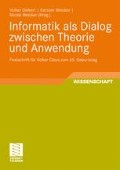Zusammenfassung
In der folgenden Ausführung geht es um eine Anwendung von Petri-Netzen im Bereich Musik. Ausgehend von der Implementierung einer speziellen Anwendung, dem Programmsystem ScoreSynth, wird das zugrundeliegende Konzept erläutert und anschließend an einem kleinen Beispiel veranschaulicht. Dieser Beitrag ist ein Auszug aus [Lev95b].
Access this chapter
Tax calculation will be finalised at checkout
Purchases are for personal use only
Preview
Unable to display preview. Download preview PDF.
Literaturverzeichnis
De Matteis, A. und G. Haus: The formalization of generative structures in Stravinsky’s „The Rite of Spring“. Journal of New Music Research, 25:47–76, 1996.
Haus, G.: Musiche Per Poche Parti. Stile libero SLCD 1012, Eufonia Series, 1989.
Haus, G. und A. Rodriguez: Formal music representation; a case study: The model of Ravel’s Bolero by petri nets. In: Haus, G. (Herausgeber): Music Processing, Computer Music and Digital Audio Series, Seiten 165–232. A-R Editions, Madison (WI), 1993.
Haus, G. und A. Sametti: SCORESYNTH a system for the synthesis of music scores based on petri nets and a music algebra (extended version). In: Baggi, D. (Herausgeber): Readings in Computer Generated Music, Seiten 53–78. IEEE Computer Society Press, 1992.
International MIDI Association, North Hollywood, CA: MIDI 1.0 Detailled Specification, Document Version 4.0, 1988.
Levens, Ursula M.: Computer-Aided Modelling of Music with Petri Nets: The Approach of Milan. Technischer Bericht M/48 (Music Series), Italian National Research Council, 1995. Finalized Project „Computer Systems and Parallel Processing“.
Levens, Ursula M.: Computerunterstütztes Modellieren von Musikstücken mit Petri-Netzen: Das Mailändere Konzept. Technischer Bericht Bericht 4/95, Carl von Ossietzky Universität Oldenburg, 1995. Berichte aus dem Fachbereich Informatik, ISSN 0946-2910.
Philipp, Siegfried: MIDI-Kompendium 2. Verlag Philipp, 1986.
Sifakis, J.: Performance evaluation of systems using nets. In: Goos, G. (Herausgeber): Net Theory and Applications, LNCS 84, Seiten 307– 319, Berlin, 1980. Springer Verlag.
Starke, P. H.: Analyse von Petri-Netz-Modellen. Teubner Verlag, Stuttgart, 1990.
Author information
Authors and Affiliations
Editor information
Rights and permissions
Copyright information
© 2009 Vieweg+Teubner | GWV Fachverlage GmbH
About this chapter
Cite this chapter
Levens, U. (2009). Computerunterstütztes Modellieren mit Musiknetzen. In: Diekert, V., Weicker, K., Weicker, N. (eds) Informatik als Dialog zwischen Theorie und Anwendung. Vieweg+Teubner. https://doi.org/10.1007/978-3-8348-9982-8_5
Download citation
DOI: https://doi.org/10.1007/978-3-8348-9982-8_5
Publisher Name: Vieweg+Teubner
Print ISBN: 978-3-8348-0824-0
Online ISBN: 978-3-8348-9982-8
eBook Packages: Computer Science and Engineering (German Language)

